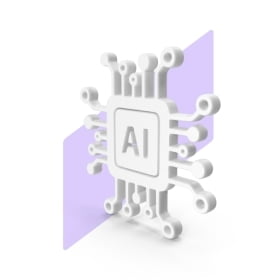Artificial Intelligence and Data Analytics
The future belongs to businesses that leverage AI to optimize their systems, operations, and customer service.
AI and data analytics empower businesses and governments beyond measures to make predictions, prevent risks, save costs, optimize revenue, track and stop fraud, optimize decision-making, and improve services.

Artificial Intelligence and Data Analytics
The future belongs to businesses that leverage AI to optimize their systems, operations, and customer service.
AI and data analytics empower businesses and governments beyond measures to make predictions, prevent risks, save costs, optimize revenue, track and stop fraud, optimize decision-making, and improve services.
Invest in Experience
Eurisko has more than a decade of experience in the development and implementation of AI and data analytics solutions In the MENA region
Grow and Expand with AI
Artificial intelligence (AI) and Data Analytics enable businesses and governments to capitalize on every emerging technology
Grow and Expand with AI
Artificial intelligence (AI) and Data Analytics enable businesses and governments to capitalize on every emerging technology
Industries
AI/ML and Data Analytics allow for a 360-degree transformation across all industries, and Eurisko makes it possible and tangible.
GamingArtificial intelligence (AI) enables the creation of immersive technologies, like virtual reality (VR) apps, and experiences; the implementation of augmented reality (AR) on all devices; the development of smarter NPCs that react, and play on different levels which surprises the player and makes the game more exciting, and the formation of different gaming paths, giving the game a more engaging detour. |
 |
Media & News PublishingAI and data analytics implementations in the digital media industry encompass all activities related to creation, distribution, and streaming. |
 |
E-Commerce & RetailAI/ML empowers consumers with more personalized experiences through purchasing recommendations, voice assistants, AI chatbots, omnichannel shopping, etc., and businesses with more efficient operations through automation, customer journey tracking, data mining, targeted personalized campaigns, etc. |
 |
IoT & Smart CitiesAI allows for the connection of systems, infrastructure, and IoT devices and the creation of smart cities, functioning at optimal capacity. |
 |
Fintech & InsurtechAI and data analytics are transforming how modern consumers use money: cash, crypto, and e-wallets; make transactions: mobile wallets, peer-to-peer (P2P) payment, and mPOS; and perform financial activities: peer-to-peer (P2P) insurance, insurance management, account management, and personal financial management. |
 |
HealthcareAI and data analytics help hospitals, laboratories, and health organizations improve their healthcare in terms of speed, accuracy, predictions, time, and cost-saving. |
 |
Key AI and Data Analytics Features
Eurisko works at international standards to provide businesses with top-quality digital solutions with the best features
FAQs
Artificial intelligence (AI) is the creation of intelligent machines that can perform tasks requiring human-like intelligence, such as recognizing speech, making decisions, and recognizing objects. AI works by using machine learning algorithms to analyze and interpret large amounts of data, and then using that analysis to make predictions or decisions.
There are three main types of machine learning algorithms:
- Supervised learning: This involves training an AI system on labeled data, where the correct answer is already known. The system learns to identify patterns in the data and make predictions based on those patterns.
- Unsupervised learning: This involves training an AI system on unlabeled data, where the correct answer is not known. The system learns to identify patterns in the data and group similar data points together.
- Reinforcement learning: This involves training an AI system through trial and error. The system receives feedback in the form of rewards or punishments based on its actions, and learns to optimize its behavior to maximize rewards.
Deep learning is a subfield of machine learning that involves training artificial neural networks with many layers, to identify and learn increasingly complex features of the data. Unlike other forms of machine learning, deep learning does not require the manual extraction of features from the data, but instead learns these features automatically as part of the training process. This makes it particularly well-suited to tasks such as image recognition, natural language processing, and speech recognition.
Data analytics is the process of using statistical and computational methods to extract insights and knowledge from data. In business, data analytics is used to analyze customer behavior, optimize business processes, identify trends and patterns, and make data-driven decisions that can improve business performance and profitability.
Big data refers to extremely large and complex data sets that are difficult to process using traditional data processing techniques. Big data is managed through the use of specialized software tools and platforms that can store, process, and analyze large volumes of data in a scalable and cost-effective manner. These tools and platforms often incorporate technologies such as distributed computing, parallel processing, and machine learning to handle the complexity and scale of big data.
Some of the most common challenges associated with implementing AI and data analytics in a business environment include:
- Data quality: Poor data quality can lead to inaccurate or unreliable insights and decisions.
- Data privacy and security: Handling large amounts of sensitive data can increase the risk of data breaches and privacy violations.
- Talent shortage: Finding and retaining skilled data scientists and AI professionals can be challenging.
- Integration with existing systems: Integrating AI and data analytics with existing systems and workflows can be complex and time-consuming.
- ROI measurement: Measuring the return on investment (ROI) of AI and data analytics projects can be difficult, as it may take time for the benefits to materialize.










